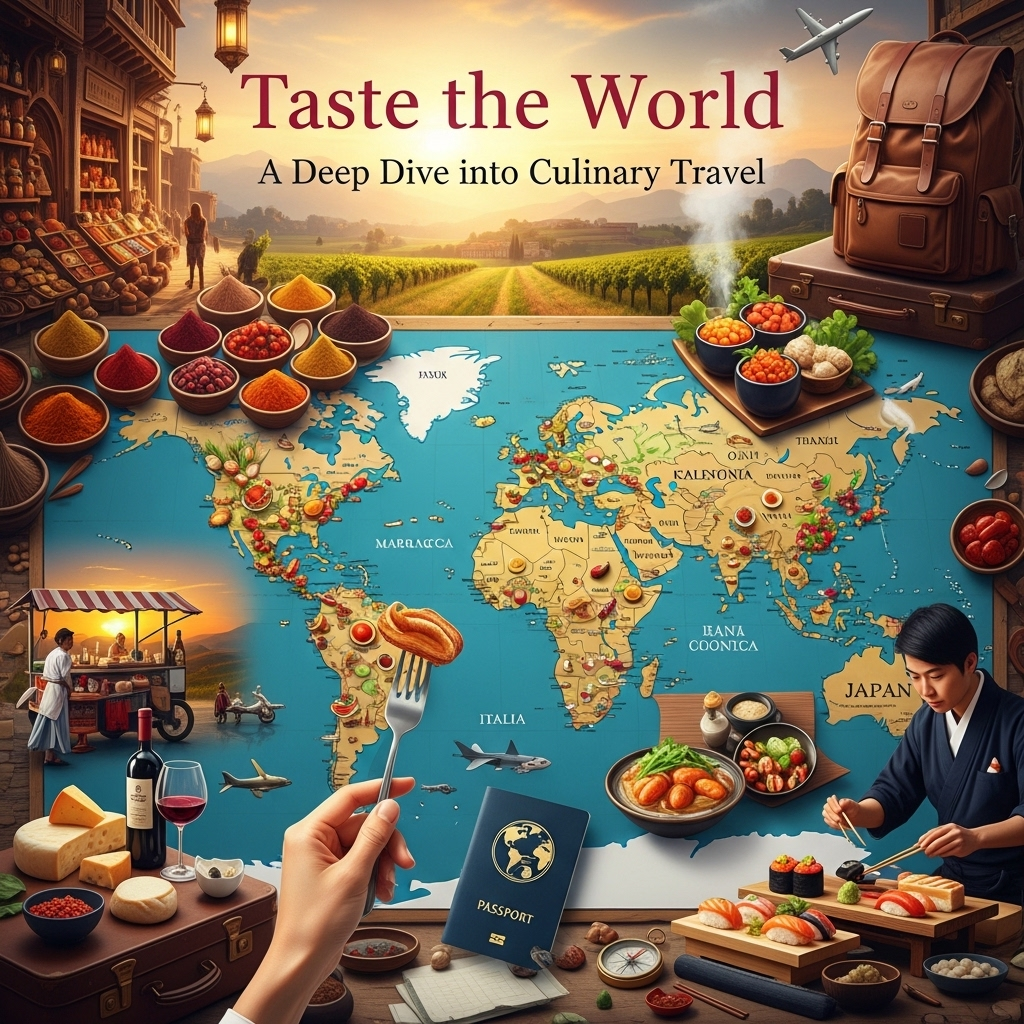Taste the World: A Deep Dive into Culinary Travel

There’s a profound saying that to truly know a place, you must taste it. This idea transcends simple nourishment. Food is the universal language, a living narrative woven into the fabric of daily life. It’s a story of history, geography, and tradition served on a plate. It’s the comforting warmth of a freshly baked loaf in a Parisian boulangerie, the complex symphony of spices in a Marrakech tagine, the communal joy of sharing tapas in a bustling Madrid bar. It is the sizzle, the aroma, the texture, and the shared laughter that connect us, bridging cultural divides in the most delicious way possible.
A trip focused on food is not just a vacation; it’s an education. It’s an active pursuit of understanding, a way to connect with the soul of a destination. But how do you move beyond the sanitized, tourist-centric restaurants and discover the authentic, heart-warming flavors that locals cherish? How do you turn a simple meal into a lasting memory? Here is a comprehensive guide for turning your next trip into an unforgettable culinary adventure, transforming you from a tourist into a true culinary traveler.
- Eat Where the Locals Eat: The Golden Rule
This is, and always will be, the cardinal rule of food travel. The most authentic and memorable meals are rarely found under the glow of a neon sign advertising “Traditional Food” in five different languages. The real magic happens in the unassuming, often-hidden spots where the community gathers.
How to Find These Hidden Gems? Venture off the beaten path. Leave the main tourist squares and wander down the quiet side streets and residential alleys. Look for places with handwritten menus, perhaps only in the local language. This is where technology can be a friend—use your phone’s translation app to decipher the offerings. A limited menu is often a sign of excellence; it means the kitchen specializes in a few dishes and makes them exceptionally well. The most reliable indicator of all? A queue of local people waiting patiently. A line of locals is a testament to quality, freshness, and value that no travel guide can rival.
Engage and Ask: Don’t be shy. Your best resources are the people around you. Ask your taxi driver where they go for a quick, delicious lunch. Inquire with your hotel receptionist (the one who works the local shift, not just the international concierge) about their favorite spot for a celebratory family dinner. Chat with a local shopkeeper. Ask them, “Where would you eat?” The answers will almost certainly lead you to a meal you won’t forget. By doing this, you’re not just finding a restaurant; you’re receiving a personal recommendation, a small gift of local knowledge. Supporting these establishments also means you’re contributing directly to the local economy, helping a family-run business thrive.
- Embrace the Street Food Scene with Confidence
Some of the most vibrant, innovative, and downright delicious food in the world isn’t served on fine china. It’s handed to you on a paper plate or in a wax-paper wrapper from a humble cart, a bustling market stall, or a hole-in-the-wall window. From the savory Banh Mi sandwiches in the bustling streets of Hanoi and the cheesy, wonderful arepas in Colombia to the sweet, cinnamon-dusted churros in Spain, street food is the raw, unfiltered pulse of a city’s culinary life.
Stay Safe, Eat Smart: The key to navigating street food safely is simple: follow the crowds. A busy stall with a high turnover is your best friend. It means the ingredients are constantly being replenished and the food is cooked fresh, not sitting around. Watch how the food is prepared. Is it being cooked to order over a hot flame or grill? Are the ingredients on display look fresh and vibrant? Observe the hygiene practices. Do the vendors handle money and food separately? Trust your senses and your gut instinct. If a place feels off, walk away. There will always be another delicious option just around the corner.
The Experience is the Point: Eating street food is an immersive experience. It’s about more than just the taste. It’s the sound of sizzling woks, the sight of steam rising into the air, the energy of the crowd, and the brief, smiling interaction with the person who has perfected their one special dish over years or even generations. It’s democracy in action—a culinary landscape accessible to everyone. If you’re feeling a little hesitant, a great way to dive in is by joining a guided food tour. Platforms like GetYourGuide often have fantastic, highly-rated local guides who can introduce you to the best and safest spots.
- Take a Cooking Class: The Souvenir That Lasts a Lifetime
What’s the best souvenir you can bring home from your travels? It’s not a trinket or a t-shirt. It’s a skill. A local cooking class is a profoundly enriching experience that offers a deeper understanding of a culture’s heart.
Beyond the Recipe: A great cooking class often begins with a trip to the local market. Guided by your instructor, you’ll learn how to select the freshest produce, identify exotic herbs, and haggle for the best spices. This is where the lesson truly begins. Back in the kitchen, you won’t just learn to follow a recipe; you’ll learn the why behind it. You’ll understand the history of a dish, the reason for a particular spice blend, and the techniques passed down through generations. You’ll hear the family stories and cultural anecdotes that give the food its soul.
Finding the Right Class: Look for small, intimate classes rather than large, impersonal demonstrations. This ensures you get hands-on experience and have the opportunity to ask questions and connect with your instructor. Check travel forums and food blogs for recommendations. Websites like Viator are excellent resources for finding and booking highly-rated, locally-run classes all over the world. The meal you prepare and share at the end of the class is often one of the most rewarding of your entire trip.
- Get Lost in a Local Market
To understand a cuisine, you must first understand its ingredients. There is no better place to do this than a local food market. It is a vibrant, chaotic, and utterly captivating assault on the senses. It’s where chefs find their inspiration, where families do their daily shopping, and where the community comes together.
A Feast for the Senses: Allow yourself to get lost in the aisles. Marvel at the kaleidoscope of colors from fruits and vegetables you may have never seen before. Inhale the earthy scent of wild mushrooms, the sweet perfume of ripe mangoes, and the pungent aroma of aged cheeses. Listen to the cacophony of vendors hawking their produce and the friendly chatter of neighbors catching up.
Interact and Sample: Be an active participant. Buy a piece of strange-looking fruit and try it. Use gestures to ask a baker for a sample of their bread. Create your own picnic by purchasing cheese from one stall, cured meats from another, and fresh bread from a third. Many larger markets, like La Boqueria in Barcelona or Borough Market in London, have small tapas bars or food stalls tucked within them, allowing you to taste dishes made from the very ingredients that surround you. A market is a living museum of a region’s agriculture and culinary traditions.
- Be Adventurous (and Know Your Limits)
Travel is about pushing your boundaries, and your palate is no exception. This is your chance to be brave. Order the dish you can’t pronounce. Try the local delicacy that sounds a bit strange. Trust the chef’s recommendation. You might not love everything you try, but you will have a story to tell, and you might just discover your new favorite food.
Learn a Little Lingo: While being adventurous, it’s also important to be smart. Before you go, learn a few key food-related phrases in the local language. Go beyond “hello” and “thank you.” Knowing how to say “What do you recommend?” (¿Qué recomienda? in Spanish) or “I am allergic to nuts” (Je suis allergique aux noix in French) is incredibly useful. A small effort to speak the language is always appreciated and can transform a simple transaction into a warm, human connection.
Adventure with Awareness: Being adventurous doesn’t mean being reckless. Be aware of your own dietary restrictions and listen to your body. If you have a sensitive stomach, ease into the local cuisine. But don’t let fear hold you back. Part of that peace of mind comes from being prepared for the unexpected, which is why we never travel without comprehensive travel insurance. A provider like World Nomads can offer protection for everything from trip cancellations to medical emergencies, letting you focus on the adventure.
Traveling for food is ultimately about connection—to the people who grow, cook, and share the food, and to the place itself. It’s about discovery, curiosity, and creating memories that linger long after the taste is gone. So on your next trip, pack your appetite, open your mind, and prepare to taste the world. Bon appétit!
I’m a content creator and writer from Morocco, passionate about travel, food, and cultural experiences. As a Media Buyer and Chef, I dedicate some of my time to crafting articles that share culinary insights, healthy living tips, and inspiring stories for curious readers.

